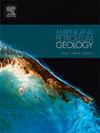Kinematic and rheological controls on ultra-wide asymmetric rifted margins evolution
IF 3.7
2区 地球科学
Q1 GEOSCIENCES, MULTIDISCIPLINARY
引用次数: 0
Abstract
Only a limited number of geodynamic numerical models have been successful in simulating both asymmetric and ultra-wide (500 km) rifted margins. In this paper, we present a comprehensive suite of 72 thermo-mechanical geodynamic numerical simulations of rifting. These simulations revealed the impact of initial crustal thickness, variations in the ratios between the upper and lower crusts, rift velocity, structural inheritance, and shear heating on the asymmetry and width of conjugate rifted margins. Our findings highlight that initial crustal thickness is a primary controlling factor of conjugate rifted margin geometries. Specifically, initial crustal thicknesses ranging from 35 to 40 km generally do not result in margins exceeding 300 km in width, where wider margins are 1.5 times longer than the narrow corresponding conjugate. An initial crustal thickness of 45 km facilitates the formation of ultra-wide margins, especially when the upper crust is thicker than the lower crust. This is attributed to the greater concentration of heat-producing elements in the thicker upper crust, which accumulates heat, weakens the crust, and promotes ductile thinning. Additionally, high rifting velocities enhance advective heating from the upwelling asthenosphere. This further influences the development of the distal margin domains and results in highly asymmetric conjugate margin pairs with one ultra-wide margin. Structural inheritance also emerges as a critical factor, as it distributes strain within the pre-rift lithosphere, thereby enhancing the development of ultra-wide (500 km) and highly asymmetric margins. Our results are compatible with conjugate rifted margins between Brazil and Africa, such as Espirito Santo - North Kwanza, Campos - South Kwanza and Santos - Benguela.
超宽非对称裂谷边缘演化的运动学和流变学控制因素
只有数量有限的地球动力数值模型成功地模拟了非对称和超宽(500 公里)裂谷边缘。在本文中,我们介绍了 72 套全面的裂谷热机械地球动力数值模拟。这些模拟揭示了初始地壳厚度、上地壳和下地壳比例变化、裂谷速度、结构继承和剪切加热对共轭裂谷边缘不对称和宽度的影响。我们的研究结果突出表明,初始地壳厚度是共轭断裂边缘几何形状的主要控制因素。具体而言,初始地壳厚度在 35 至 40 千米之间的边缘宽度一般不会超过 300 千米,其中较宽的边缘长度是较窄的共轭边缘长度的 1.5 倍。初始地壳厚度为 45 千米时,有利于形成超宽边缘,特别是当上部地壳比下部地壳厚时。这归因于较厚的上地壳富集了更多的产热元素,从而积聚了热量,削弱了地壳,促进了韧性变薄。此外,高的断裂速度增强了上涌岩浆层的平流加热。这进一步影响了远端边缘域的发展,导致了高度不对称的共轭边缘对和一个超宽边缘。结构继承也是一个关键因素,因为它分布了前裂谷岩石圈内的应变,从而促进了超宽(>500 km)和高度不对称边缘的发展。我们的研究结果与巴西和非洲之间的共轭裂谷边缘相吻合,例如圣埃斯皮里图-北宽扎、坎波斯-南宽扎和桑托斯-本格拉。
本文章由计算机程序翻译,如有差异,请以英文原文为准。
求助全文
约1分钟内获得全文
求助全文
来源期刊

Marine and Petroleum Geology
地学-地球科学综合
CiteScore
8.80
自引率
14.30%
发文量
475
审稿时长
63 days
期刊介绍:
Marine and Petroleum Geology is the pre-eminent international forum for the exchange of multidisciplinary concepts, interpretations and techniques for all concerned with marine and petroleum geology in industry, government and academia. Rapid bimonthly publication allows early communications of papers or short communications to the geoscience community.
Marine and Petroleum Geology is essential reading for geologists, geophysicists and explorationists in industry, government and academia working in the following areas: marine geology; basin analysis and evaluation; organic geochemistry; reserve/resource estimation; seismic stratigraphy; thermal models of basic evolution; sedimentary geology; continental margins; geophysical interpretation; structural geology/tectonics; formation evaluation techniques; well logging.
 求助内容:
求助内容: 应助结果提醒方式:
应助结果提醒方式:


